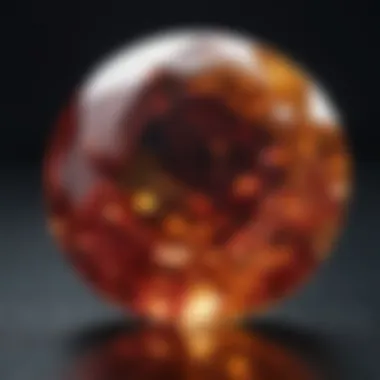Understanding Lapidary Saw Oil: Essential Insights


Intro
The purpose of this comprehensive exploration is to delve into lapidary saw oil, a crucial element in the gemstone industry. This section will set the stage for understanding the interplay between this oil and various gemstones. By examining its properties and applications, one can gain insight into how lapidary saw oil enhances the cutting and polishing processes, ultimately impacting the final aesthetic of the gemstones.
Gemstone Overview
Definition and Characteristics
Gemstones are naturally occurring minerals, rocks, or organic materials that are cut and polished to create jewelry and decorative items. They possess unique characteristics that define their value and appeal, such as hardness, clarity, color, and brilliance. These features are essential for jewelers and gem enthusiasts when selecting suitable materials for cutting and crafting.
Many gemstones are classified based on their chemical composition and crystal structure. Common examples include diamonds, sapphires, and amethysts. Each gemstone offers distinctive properties:
- Hardness: Measured on the Mohs scale, indicating resistance to scratching.
- Clarity: Refers to the presence of internal or external flaws.
- Color: Varies widely among gemstones, influencing desirability.
- Brilliance: The way light reflects and refracts within the stone.
Classification of Gemstones
Gemstones can be classified into two main categories: precious and semi-precious. Precious gemstones, such as diamonds, rubies, sapphires, and emeralds, are highly sought after for their rarity, beauty, and durability. In contrast, semi-precious stones encompass a broader range of materials like garnets, peridots, and citrines, which are also valued but tend to be more abundant.
The classification system is not only important for identifying unique properties but also for understanding the necessary tools and techniques, including the role of lapidary saw oil, in processing these stones.
"Lapidary saw oil is integral in minimizing friction, cooling the blade, and enhancing the quality of cut, thus preserving the integrity of the gemstone."
Historical Significance
Ancient Uses and Cultural Importance
Throughout history, gemstones have held significant meanings across various cultures. They were often attributed with mystical properties or used as symbols of status. In ancient Egypt, lapis lazuli was treasured, not only for its beauty but also for its believed protective qualities. Similarly, in Indian cultures, certain gemstones were associated with astrology and were worn to enhance one’s fortune.
Myths and Legends Surrounding Gemstones
Myths and folklore further enrich the narrative surrounding gemstones. For example, in ancient Greece, amethyst was believed to protect against intoxication. Such beliefs have informed the practices of jewelers over centuries, influencing gemstone selection and use in lapidary arts. Understanding these cultural backgrounds complements the technical knowledge about lapidary saw oil, showcasing how both tradition and innovation work hand in hand in the world of gemology.
Prelims to Lapidary Saw Oil
Lapidary saw oil plays a crucial role in the processes of cutting and polishing gemstones. Understanding this topic is essential for anyone involved in gemology. The usage of saw oils not only enhances the efficiency of cutting but also ensures better precision in achieving desired shapes. Moreover, the right saw oil can significantly affect the outcome of polishing, leading to superior surface finishes.
Definition and Purpose
Lapidary saw oil is a specialized lubricant designed to reduce friction and heat during the cutting and polishing of hard materials, mainly gemstones. These oils serve multiple purposes, such as:
- Cooling: They help in dissipating heat generated by the saw blades, preventing overheating that could damage both the tool and the stone.
- Lubrication: The oils allow blades to cut smoothly through various materials, reducing wear on the equipment.
- Cleaning: Saw oils can help remove debris and particles from the surface of gemstones, ensuring a cleaner cut.
The choice of saw oil directly influences not only the cutting experience but also the lifespan of cutting tools. Thus, selecting the right type of lapidary saw oil is vital for jewelers and gem enthusiasts alike.
History of Saw Oils in Lapidary Practices
The history of saw oils in lapidary work dates back centuries. Initially, lapidaries relied on natural oils, such as vegetable and animal fats, to perform cutting and polishing. These early oils had limitations in terms of performance and temperature control. As technology advanced, petroleum-based oils became popular due to their superior lubrication properties.
In the late 20th century, the introduction of synthetic oils marked a significant shift in the industry. These synthetic formulations provided enhanced performance, including better viscosity and temperature resistance. Over the years, lapidary practices adapted to these innovations, leading to more effective and safe methods of gemstone processing.
Today, with a diverse range of oils available, lapidaries can choose products tailored for specific applications, enhancing overall efficiency in their craft.
Chemical Composition of Lapidary Saw Oil


Understanding the chemical composition of lapidary saw oil is essential for realizing its function and effectiveness in gemstone processing. The right mixture of base oils and additives significantly influences the oil's efficacy. Each component plays a role in the performance, compatibility, and overall results in cutting and polishing gemstones.
Base Oils and Additives
The base oils form the primary component of lapidary saw oils. These oils vary, typically encompassing petroleum-derived, vegetable-based, or synthetic options. Each type boasts distinct properties that affect the cutting performance.
- Petroleum-based oils are the most common. They offer good lubricity and chemical stability, making them suitable for various applications. However, they may not be environmentally friendly.
- Vegetable-based oils are gaining popularity due to their renewable nature. These oils usually provide adequate lubrication but may not perform as well under high temperatures.
- Synthetic oils often provide superior performance, especially in extreme conditions. They are engineered for specific characteristics, including high lubricity and thermal stability.
In addition to base oils, various additives enhance the performance of lapidary saw oils. These may include anti-foaming agents, rust inhibitors, and extreme-pressure additives. Each of these plays a role in ensuring that the oil maintains its properties during rigorous use. The right blend of base oil and additives is vital for optimal results in cutting and polishing.
Viscosity and Lubrication Properties
Viscosity is a critical characteristic of lapidary saw oil. It determines how the oil flows and its capability to provide lubrication under various conditions. Adequate viscosity allows the oil to adhere to the tool and work surface, reducing friction and heat generation during cutting activities.
- A higher viscosity means the oil can create a thicker lubricating film, which is beneficial in minimizing wear and tear on blades. However, too high viscosity can lead to challenges in flow, especially in colder conditions.
- On the contrary, lower viscosity oils might flow easily, offering rapid coverage but potentially providing insufficient protection under high-stress scenarios.
The lubrication properties of lapidary saw oil also contribute to the surface finish of the gem materials. An adequately lubricated surface results in cleaner cuts and better polish quality, essential for professionals.
The interplay between chemical composition and the cutting process cannot be overstated. Each component influences performance, making it crucial for users to select oils that align with their specific needs.
Types of Lapidary Saw Oils
Lapidary saw oils play a significant role in the cutting and polishing of gemstones. Understanding the various types of saw oils available is crucial for hobbyists and professionals alike. Each type has unique properties that affect performance, handling, and the outcome of the gemstone processing. By comprehending the distinctions among water-soluble oils, petroleum-based oils, and synthetic oils, users can make informed choices to enhance their lapidary work.
Water-Soluble Oils
Water-soluble oils are formulated to mix well with water. This characteristic makes them easier to clean up after use. Such oils are often less messy, which is beneficial for artists working in smaller spaces or those who prefer a tidy work environment.
Furthermore, water-soluble oils tend to be less harmful to the environment. Because they can be easily diluted, proper disposal becomes simpler. However, they may not provide the same level of lubrication compared to their petroleum-based counterparts. This could potentially affect cutting efficiency under certain conditions. Users need to strike a balance between ease of use and performance when choosing this type of oil.
Petroleum-Based Oils
Petroleum-based oils are among the most commonly used in the lapidary field. These oils typically deliver excellent lubrication and cooling properties, which enhance cut quality and tool longevity. The viscosity of these oils allows them to adhere well to the saw blades, reducing friction and heat during operation.
However, there are drawbacks to using petroleum-based oils. They can emit harmful fumes, posing health risks if not used in a well-ventilated area. Moreover, proper disposal can burden users due to environmental concerns. It's vital for users to adhere to stringent safety protocols when handling these oils.
Synthetic Oils
Synthetic oils represent the latest advancement in lapidary saw oil technology. They are designed to offer superior lubrication, heat resistance, and cleaning convenience. Their composition can be tailored for specific tasks, enabling custom applications based on the gemstones being processed. Synthetic oils also tend to have a longer shelf life and can be environmentally friendlier.
Although synthetic oils often come at a higher initial cost, their performance and efficiency gains may justify this expense over time. They can minimize the environmental impact thanks to lower volatility and reduced emissions. Ultimately, the choice to use synthetic oils depends on the user's preferences and the specific demands of their projects.
Choosing the right lapidary saw oil is not just about functionality; it also reflects a commitment to safety and environmental stewardship.
Applications in Gemstone Processing
The role of lapidary saw oil in gemstone processing cannot be overstated. It is an essential component that enhances efficiency during cutting and polishing. In this section, we will explore the critical applications of lapidary saw oil, focusing on how it influences techniques used in the field. Understanding these applications helps gem enthusiasts and professionals make informed decisions when working with various gemstones.
Cutting Techniques
Lapidary saw oil serves as a lubricant that reduces friction between the saw blade and the stone being cut. This lubrication is vital for several reasons:
- Reduced heat generation: Excess heat can damage both the gemstone and the saw blade. Using lapidary saw oil helps in dissipating heat, allowing for a smoother cutting process.
- Improved precision: A well-lubricated saw operates more smoothly, resulting in cleaner cuts. This precision is crucial for jewelers who require exact shapes and facets in their gemstones.
- Increased blade lifespan: Constant friction can lead to premature wear of the saw blade. The use of lapidary saw oil minimizes wear and extends the service life of the blade.


Different cutting techniques can benefit from distinct formulations of lapidary saw oil. For instance, heavy oils may be used in cutting harder stones, while lighter oils might suit softer materials. Selecting the right oil type is essential for optimizing cutting performance.
Polishing Processes
Once the initial cutting is completed, the next phase is polishing. Lapidary saw oil plays a supportive role during this stage as well. In polishing, the main objectives are to smooth the surface and enhance the overall appearance of the gemstone.
- Enhanced surface finish: Lapidary saw oil allows polishing compounds to work more effectively. When lubricated, the polishing materials can move freely across the stone surface, improving the level of smoothness and shine.
- Reduction of scratches: A properly lubricated polishing procedure helps in preventing scratches that can occur when abrasive materials come into contact with the stone. This is particularly important for high-value gemstones where any imperfection can detract from the overall value.
- Stopping debris accumulation: During polishing, fine debris can build up on the workspace, affecting the quality of the finish. Lapidary saw oil aids in rinsing away some of this debris, ensuring a cleaner working environment.
By analyzing these applications, it becomes clear that lapidary saw oil is indispensable. Its utility not only enhances the processes of cutting and polishing but also ensures the integrity of valuable gemstones.
"Lapidary saw oil is crucial for any serious gem cutter, providing the needed lubrication that underpins quality in both cutting and polishing techniques."
The insightful application of lapidary saw oil elevates the craft of gemology. This knowledge proves beneficial not just for professionals, but also for hobbyists keen on refining their skills in gemstone processing.
Advantages of Using Lapidary Saw Oil
Lapidary saw oil is essential in gemstone processing due to the several advantages it provides over dry cutting methods. The use of these oils is critical in maximizing efficiency, ensuring durability of tools, and achieving superior surface finishes. Understanding these benefits allows jewelers and enthusiasts to make informed choices regarding their lapidary practices.
Enhanced Cutting Efficiency
One of the primary benefits of lapidary saw oil is its ability to enhance cutting efficiency. The viscous nature of these oils provides a lubricant layer between the blade and the gemstone. This lubrication reduces friction, allowing the saw to cut through materials with less resistance. The result is a faster cutting process, which can be particularly beneficial when working with hard gemstones like quartz or sapphire. Furthermore, optimal oil usage minimizes heat generation during the cutting process. Excess heat can lead to thermal shock in gemstones, resulting in cracks or fractures. Therefore, by maintaining an appropriate temperature during cutting, lapidary saw oil plays a vital role in preserving the integrity of the stone being worked on.
Extended Tool Life
Using lapidary saw oil also contributes significantly to the longevity of the tools employed in gemstone processing. The oil acts as a protective barrier against wear and tear that often occurs during the cutting and polishing processes. It helps to prevent abrasive particles from accumulating on the blade, which could otherwise lead to premature dulling or damage. With regular use of suitable oil, operators can expect to extend the life span of their saw blades and other lapidary equipment. In the long run, this translates to reduced costs and less frequent tool replacements.
Improved Surface Finish
Another important advantage of lapidary saw oil is the improvement in surface finish on gemstones. The smooth application of oil not only aids in the cutting process but also enhances the quality of the final product. When oil is used, the surface of the gemstone is less likely to sustain scratches or blemishes, which are often a consequence of dry cutting. This results in a refined polish that is crucial for jewelry makers and gemstone designers who require their products to meet high aesthetic standards. A well-finished gemstone can significantly increase its market value and appeal. Thus, lapidary saw oil is not just about cutting materials effectively; it is also about achieving the desired quality and clarity in the final output.
"The use of lapidary saw oil leads to more than just practical benefits; it fundamentally enhances the craft of gemology itself, allowing for precision and artistry."
In essence, the advantages of using lapidary saw oil are manifold. From enhancing cutting efficiency, extending the lifespan of tools, to improving the surface quality of gemstones, these oils are a crucial component of effective lapidary practices. By investing in high-quality lapidary saw oil, enthusiasts and professionals alike can ensure superior results in their gemstone processing endeavors.
Safety and Environmental Considerations
The importance of safety and environmental considerations cannot be overstated when discussing lapidary saw oil. This section examines both functional aspects of safety and the potential ecological impact of the oils used in lapidary practices. By understanding these elements, users can make informed choices that protect not only themselves but also the broader environment.
Safety Precautions During Use
To maximize safety while using lapidary saw oil, it is essential to follow specific precautions. Proper personal protective equipment (PPE) is a necessity. This includes gloves, goggles, and protective clothing to mitigate exposure to oils that may irritate skin or eyes.
- Ensure workspaces are well-ventilated. Fumes from heated oil can be harmful if inhaled.
- Avoid skin contact by wearing appropriate gloves at all times.
- In case of spills, clean immediately to prevent slipping hazards.
- Familiarize oneself with the Material Safety Data Sheet (MSDS) for the specific oil being used. This provides critical information regarding hazards and first-aid measures.
Additionally, using oils in moderation can help prevent overheating. This not only extends the life of the saw blade but also minimizes the risk of ignition, which can occur if the oil becomes excessively hot.
Environmental Impact of Lapidary Oils
Late in the discussion of lapidary saw oil, it is crucial to consider the environmental implications of its use. Many types of saw oils contain petroleum-based components that can have detrimental effects on the ecosystem when improperly disposed of. When these oils enter water systems, they can disturb aquatic life and degrade water quality.
- Biodegradability: Some oils are designed to be more environmentally friendly. Synthetic formulations often have lower environmental impact compared to traditional petroleum-based oils.
- Disposal: Proper disposal methods must be in place. Oils should never be poured down a drain or thrown in regular trash. Consult local regulations for hazardous waste disposal services.
- Sustainability: Users should consider more sustainable alternatives when available, such as bio-based oils that offer reduced environmental impact without compromising performance.
It is essential to remember that responsible practices in using lapidary saw oils contribute to a safer workplace and a healthier planet.


Maintaining Lapidary Saw Oil
Maintaining lapidary saw oil is crucial for ensuring optimal performance in the cutting and polishing of gemstones. It involves two main aspects: storage and disposal. Proper maintenance not only extends the life of the oil but also promotes safety and environmental stewardship. If lapidary saw oil is not properly stored or disposed of, it can lead to unnecessary waste and potential hazards.
Storage Guidelines
The conditions under which lapidary saw oil is stored significantly affect its longevity and effectiveness. Here are some important guidelines for storage:
- Keep Away from Sunlight: Exposure to direct sunlight can degrade the oil's quality quickly. Store the oil in a cool, dark place to minimize degradation.
- Seal Containers Properly: Always ensure that the containers are tightly sealed after each use. Inadequately sealed containers can lead to evaporation and contamination.
- Temperature Control: Ideally, store lapidary saw oil in a temperature-controlled environment. Extreme temperatures can alter its properties, making it less effective for its intended purposes.
- Labeling: Clearly label containers with the type of oil and the date of purchase. This practice helps in monitoring oil usability and avoiding confusion about products.
Following these guidelines helps maintain the integrity of the lapidary saw oil, ensuring that gem cutters and enthusiasts can perform their tasks efficiently.
Disposal Best Practices
Proper disposal of lapidary saw oil is important for minimizing potentially harmful environmental effects. Here are best practices to follow:
- Check Local Regulations: Always follow local regulations regarding the disposal of oils and chemicals. Some areas have specific guidelines that must be adhered to, while others may require taking the oil to a designated disposal facility.
- Avoid Draining into Sewers or Drains: Never dispose of lapidary saw oil by pouring it down the drain or disposing of it in landfills. This action can contaminate water supplies and the local ecosystem.
- Recycling Options: Investigate if recycling options are available for spent oils. Certain facilities can process used oils and convert them into new products.
- Use Absorbents for Cleaning: When cleaning up spills, use absorbent materials that can be safely disposed of as per the local regulations. This minimizes environmental impact while maintaining workplace safety.
Adhering to these disposal practices not only protects the environment but also reflects a commitment to responsible gem-cutting practices.
"To preserve our gemstones and tools, we must be vigilant about how we maintain and dispose of our lapidary saw oils."
By understanding and implementing appropriate maintenance practices, gemstone enthusiasts can significantly enhance their experience, ensuring that lapidary saw oil continues to play a vital role in gemology.
Future Trends in Lapidary Saw Oils
The lapidary industry is undergoing changes, largely influenced by technological advancements and environmental concerns. Understanding future trends in lapidary saw oils is vital for gemstone professionals and enthusiasts alike. These trends can affect efficiency, safety, and sustainability in their practices.
Innovations in Formulation
Innovations in formulation of lapidary saw oils are crucial for meeting the evolving demands of gemstone processing. Manufacturers are continuously experimenting with new combinations of base oils and additives, resulting in products that offer better performance and efficiency. The development of oils with lower viscosity provides improved flow properties, enhancing cooling and lubricating effects during cutting.
Moreover, there is a notable trend toward biotechnology in the formulation processes. Some companies explore bio-based oils derived from natural sources, providing an environmentally friendly alternative to traditional petroleum-based products. These formulations not only prioritize sustainability but also aim to reduce the carbon footprint associated with lapidary practices.
Continued research is leading to enhanced additives that improve cutting speed and reduce tool wear. These advancements ensure that lapidary saw oils remain integral in maximizing productivity while ensuring the safety of machinery involved in gem processing.
Sustainability Initiatives in the Industry
Sustainability is becoming a key focus for many industries, and the lapidary sector is no exception. Initiatives aimed at reducing environmental impact are gaining traction within the market for lapidary saw oils. Many manufacturers are adopting sustainable sourcing strategies, ensuring that raw materials used in their products are sourced responsibly and ethically.
Additionally, efforts are being made to develop fully biodegradable saw oils. This move is crucial as it addresses potential soil and water contamination issues associated with traditional oils. Biodegradable oils can break down naturally, posing less risk to the environment.
Industry players are also improving their production processes to minimize waste and energy consumption. As more jewelers and gemstone enthusiasts become aware of the need for sustainable practices, companies that promote environmentally friendly products will likely gain competitive advantages.
By emphasizing sustainability in formulation and practices, the lapidary industry can ensure a balanced approach to gem processing for future generations.
The End
The conclusion is a pivotal element in this discussion on lapidary saw oil. It encapsulates the essence of the entire article and reinforces the critical points raised throughout. By summarizing the extensive benefits and practical uses of lapidary saw oil, the conclusion serves as a pivotal reflection for readers who seek to deepen their understanding of this subject.
Summary of Key Points
The main points covered include the definition and purpose of lapidary saw oil, its chemical composition, and the various types available. The advantages of using such oils in gem processing are substantial. Improved cutting efficiency, tool longevity, and enhanced surface finish all play a vital role in achieving high-quality results in gemstone cutting and polishing. Furthermore, safety considerations and the environmental implications of using lapidary oils were discussed, emphasizing the significance of careful handling and disposal practices.
- Definition and Purpose: Lapidary saw oil serves as a lubricant and coolant during cutting and polishing processes.
- Types of Oils: Various types like water-soluble, petroleum-based, and synthetic oils provide different benefits suited for specific tasks.
- Advantages: Significant improvements in efficiency and tool lifespan were noted.
- Safety Measures: Proper precautions ensure safe use, while understanding the environmental impact is crucial for sustainable practices.
Final Thoughts on Lapidary Saw Oil's Role in Gemology
"The role of lapidary saw oil transcends mere lubrication; it bridges the gap between raw gem material and the polished masterpiece."
This exploration into lapidary saw oil emphasizes its critical nature in modern gem processing practices. Understanding its applications and implications undoubtedly empowers gemstone lovers to enhance their methods and outcomes in gemology.







